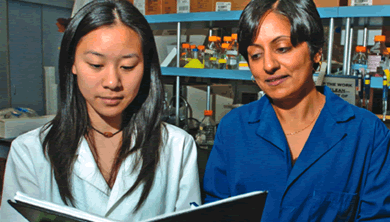Prolonging Life
Researchers explore the anti-aging properties of manganese
October 29, 2007
By Russ Hudson
It is a common, one millimeter-long worm found in soil and rotting trees. But, this tiny creature — Caenorhabditis elegans, or C. elegans — shares about 40 percent of the same DNA as humans and it ages like one, losing muscle mass and functions.
Because it has a relatively short life span — ordinarily less than three weeks — it can be carefully observed throughout its lifecycle. That is essential, because the goal of the National Institutes of Health-funded research being conducted by Chandra Srinivasan, assistant professor of biochemistry, and her student researchers in the Dan Black Hall laboratory is to explore the antioxidant properties of manganese supplements, including how long manganese can extend the lives of the little nematodes (round worms).

Kim Trinh, left, and Chandra Srinivasan check their data.
Some day, it could have applications to humans and how long they live.
“Sixteen to 18 days,” Srinivasan said. “That’s the standard life span of a normal C. elegans. When we included the mineral, manganese, as a supplement in their diets, they lived about 15 percent longer. We added even more, thinking we’d see toxicity from that level of manganese. Instead, they lived a little longer even.”
For humans, that could mean more than 12 years.
“We even used C. elegans that were identified by other labs as having genetic defects that shortened their lives by several days. Again, manganese helped them to live about 15 percent longer,” Srinivasan said.
Srinivasan is not alone in this research. Thousands of scientists, including those at such places as Harvard, Stanford, MIT, Buck Institute, Johns Hopkins and UCLA, are trying to find out what can add years to the human life span. Some of those labs also are looking at manganese, “but we are the first group to start using multicellular organisms for this particular research,” Srinivasan said. “Others are using bacteria or yeast.”
Her lab is the first to show that manganese is beneficial to C. elegans, she said.
Srinivasan collaborates with a number of other research groups, including those at Johns Hopkins and UCLA.
Among those in the lab with her are biochemistry student Kim Trinh, biology majors Alvaro Villarreal, Richard Parenteau and Stephanie Sprowl and biology and psychology major Keyan Matinpour and graduate biochemistry student Natalie Rangel. Srinivasan said she attempts to have students at all levels, including graduates, working with her at the same time.
That way, she said, the students can help guide each other and, when they graduate, they are fully familiar with the principles of research.
In fact, Rangel co-authored two papers on the research, “Measuring ‘free’ iron levels in Caenorhabditis elegans using low-temperature Fe(III) electron paramagnetic resonance spectroscopy” in Analytical Biochemistry in 2006, and “Manganous Ion Supplementation Accelerates Wild-Type Development, Enhances Stress Resistance and Rescues the Life-Span of a Short Lived Caenorhabditis elegans Mutant” in Free Radical Biology and Medicine in 2005.
The supposition she is exploring is that manganese
helps the worms resist the free radicals that promote aging. Free radicals
are chemical compounds in the body with an unstable number of electrons.
Because of their instability, free radicals can chemically react with
cellular components in the body, causing damage. That damage, as it collects
over time, is a major contributor to the
aging process.
Antioxidants can counteract the free radicals. Manganese appears to be helping to counteract free radicals in C. elegans, Srinivasan and her students explained, thereby minimizing the damage.
“What we don’t know, at this time, is whether the manganese is itself acting as an antioxidant or if it is enabling other antioxidants in C. elegans’s system to counter the free radicals,” Srinivasan said.
Srinivasan will not draw conclusions yet about what the research will mean to humans: “It’s too soon to tell. Right now we’re doing good science and good work, adding to the knowledge base on manganese. At the appropriate time, this will step up to mammalian research.”
But,
she stresses caution. Miners and welders are exposed to manganese during
their work, she pointed out, “and some of them get Parkinsons-like
symptoms, which may be related to manganese toxicity. Of course, the
big difference is that they are inhaling manganese particles, not ingesting
them.”
Srinivasan said she refuses to extrapolate from the research or change
her habits because of it.
“One of the researchers at Johns Hopkins told me he has started taking manganese supplements,” she said. “I’m not ready to do that. I just make certain I have a balanced diet, including whole grains, which is a good dietary source of manganese.”
Printable PDF of this article: http://campusapps.fullerton.edu/news/inside/2007/Story_PDFs/Nov_prolonginglife.pdf


